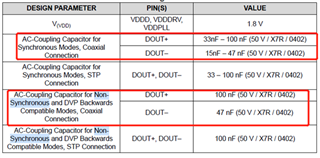Hi Team,
Customer found that non-Synchronous is more stable in low temp. So would like to ask the following questions.
1. Is it true that Synchronous mode and Non-Synchronous have different requirements for peripheral circuits, especially the requirements of S11 and S12 are different. Is Synchronous mode more stringent?

2.Which one is more stable? Non-Synchronous external clock or Non-Synchronous Internal Clock mode?
3. As for Non-Synchronous external clock, how to chose from 25M and 50M

4.Is Non-Synchronous only able to run 2G mode, and the AC capacitor here must be strictly selected 100nf+47nf, the AC capacitor selection here is selected according to the mode selection, or due to the change of speed.

5. If we choose Non-Synchronous mode, but we choose the combination of 33nf+15nf for the AC capacitor? What are the risks?

